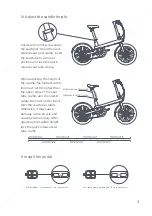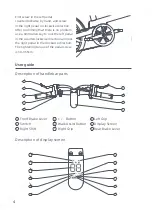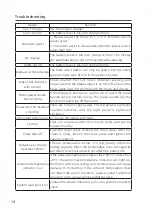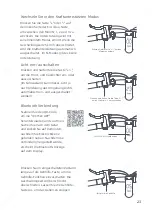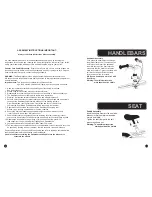
9
Riding
• Cycling involves risk of personal injury and damage of the bike, you should
assume the responsibility for that risk. For your safety, please follow the
cycling rules with properly using the bike, as well as regularly carry out the
maintenance, which can reduce the risk of injury. This user manual contains
warnings and precautions concerning the consequences of failure to maintain or
inspect your bike, and of failure to follow safe cycling practices.
As with all mechanical components, electric bicycles are subject to wear and
high stress. Different materials and components may react to wear or stress
fatigue in different ways. If a component's service life has passed, it may
suddenly fail and cause personal injury. Any cracks, scratches, or color change in
the high-stress areas indicate that the component's service life has passed and
should be replaced. If there was any impact on the bicycle due to a collision,
it is recommended to immediately go to an official dealer for inspection and
maintenance. The user may not be able to see the damage caused by impact
on the components made of composite materials, which may result in a second
accident and personal injury.
1. Check the front and rear brakes before use, and adjust them if necessary. The
front brake is controlled by the left brake lever and the rear brake is controlled
by the right brake lever. After properly adjusting the brakes, the bicycle should
brake reliably when pulling both the left and the right brake lever halfway. When
the brake pads are worn excessively, they must be replaced in time.
2. Check whether the chain is properly lubricated before using the bicycle. Turn
the pedal by hand and check whether the chain links move smoothly and are
corrosion-free. If the chain is corrosive or frozen, add an appropriate amount of
lubricant, or replace the chain if necessary.
3. Before riding the bicycle, check the tire pressure, the handle bar movement,
the rotation of the front and rear wheel, the electrical circuit, the battery level
and the working condition of the motor, as well as the lights, bell, and fasteners.
(1) Low tire pressure will increase the friction between the tire and the road
surface. This will increase the tire's wear and thus reduce its total mileage. It will
also negatively affect the bicycle's handling and steering, and thereby reducing
comfort and safety. If the tire pressure is too low, immediately inflate the tires.
The recommended tire pressure is 40–65 PSI.
(2) If the handle bar is stuck or does not turn smoothly, it should be adjusted or
lubricated in time. Use calcium-based or lithium-based grease as a lubricant.
First loosen the front fork's locknut, then turn the front fork's upper block. Once it
is adjusted as preferred, tighten the front fork’s locknut.
(3) If the front and rear wheel do not rotate smoothly due to friction, the bicycle's
power consumption will increase and its mileage will reduce. To prevent failure,
make sure the bicycle is lubricated and maintained in a timely manner. Use
calcium-based or lithium-based grease as a lubricant. If the hub fails, replace
iRiding (Shenzhen) Technology Co., Ltd.
iRiding (Shenzhen) Technology Co., Ltd.
iRiding (Shenzhen) Technology Co., Ltd.
iRiding (Shenzhen) Technology Co., Ltd.
iRiding (Shenzhen) Technology Co., Ltd.
iRiding (Shenzhen) Technology Co., Ltd.
iRiding (Shenzhen) Technology Co., Ltd.
iRiding (Shenzhen) Technology Co., Ltd.
iRiding (Shenzhen) Technology Co., Ltd.
iRiding (Shenzhen) Technology Co., Ltd.
iRiding (Shenzhen) Technology Co., Ltd.
iRiding (Shenzhen) Technology Co., Ltd.
iRiding (Shenzhen) Technology Co., Ltd.
iRiding (Shenzhen) Technology Co., Ltd.
iRiding (Shenzhen) Technology Co., Ltd.
iRiding (Shenzhen) Technology Co., Ltd.
iRiding (Shenzhen) Technology Co., Ltd.
iRiding (Shenzhen) Technology Co., Ltd.





